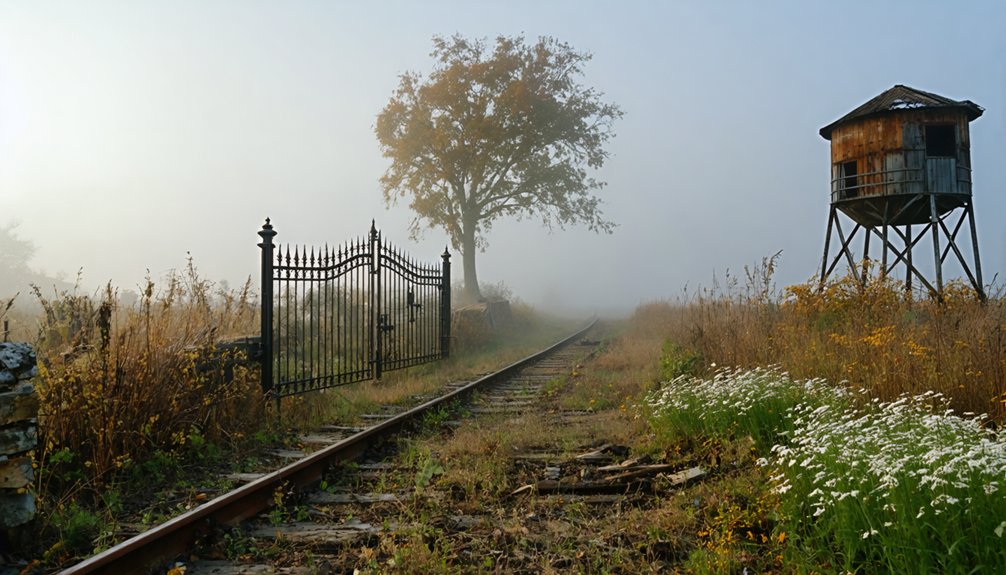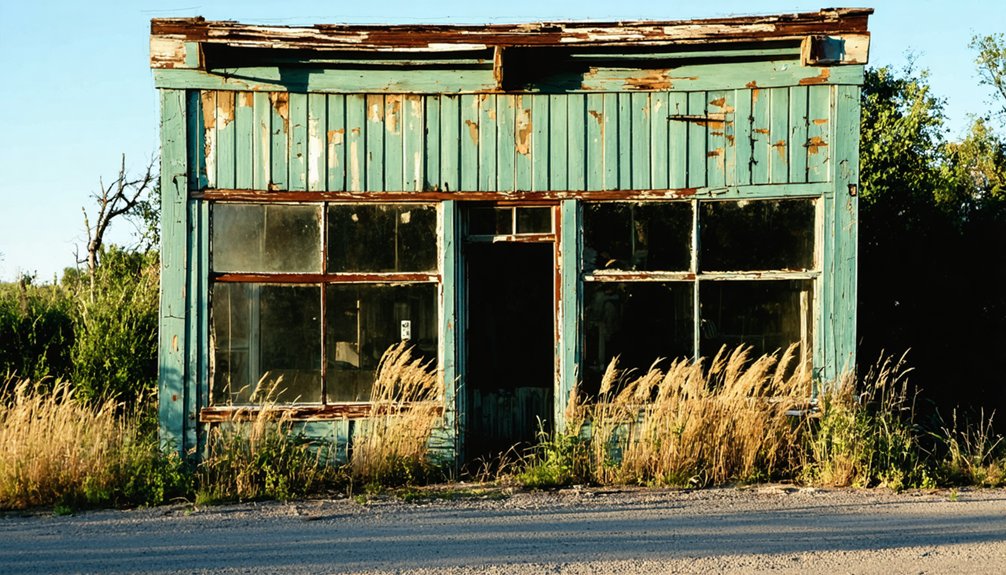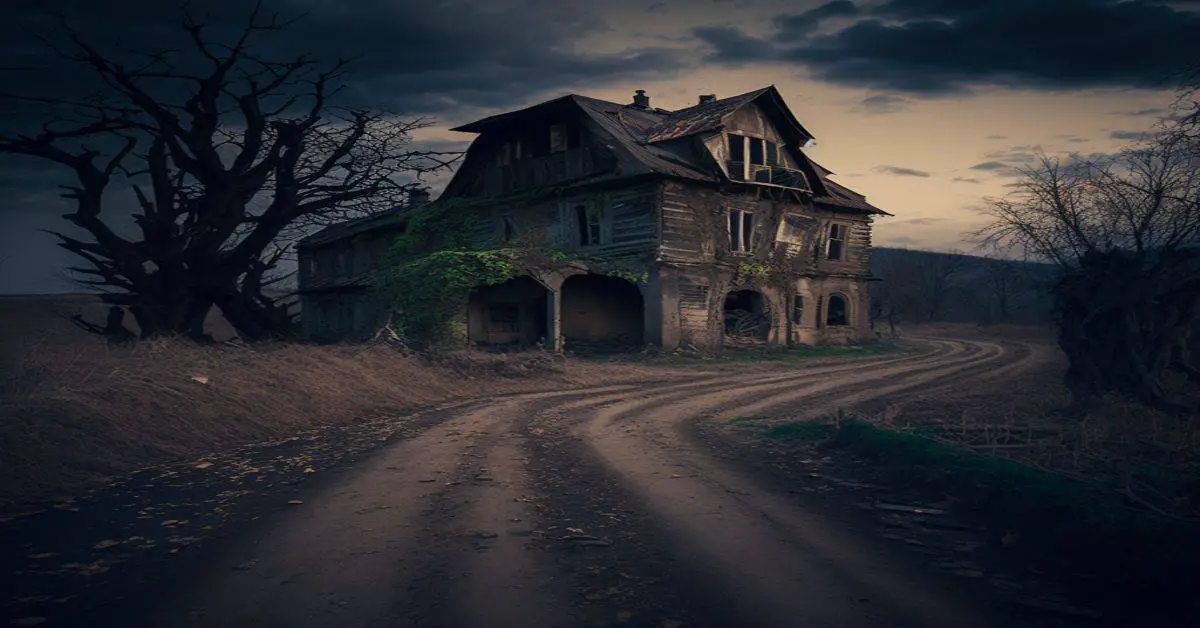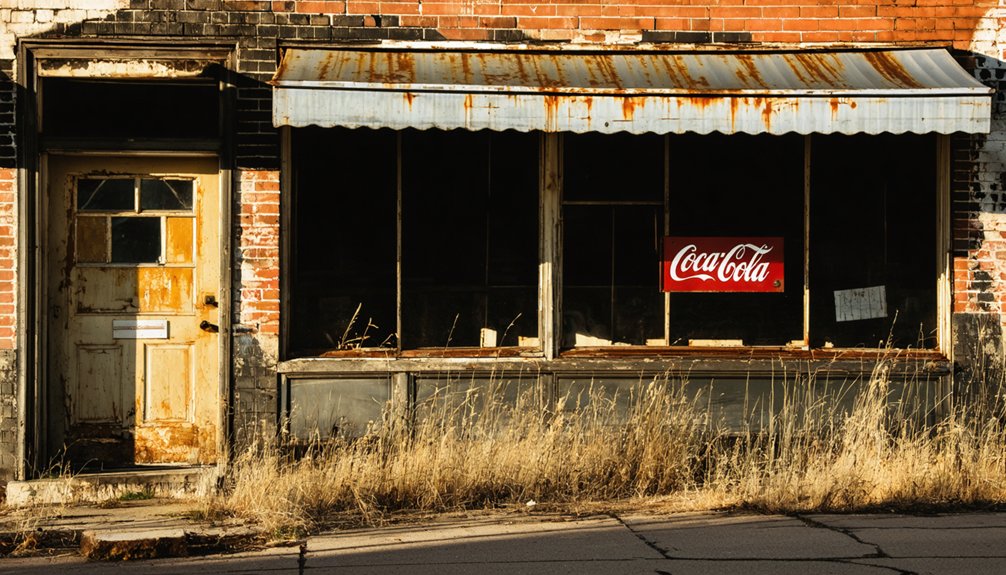You’ll find Millsdale’s remains in Will County, Illinois, where it once thrived as a strategic railroad hub along the Des Plaines River. Established by the Atchison, Topeka and Santa Fe Railway, this ghost town served as an essential livestock transport center to Chicago markets in the late 1800s. While Oscar Mills’ brick factory and stockyard operations shaped the community’s brief development, today only scattered foundation stones peek through vegetation at the former site, now home to Stepan Chemicals Company’s industrial facility. The town’s dramatic transformation from railway stop to industrial zone reveals a fascinating story of economic evolution.
Key Takeaways
- Millsdale was established by the Atchison, Topeka and Santa Fe Railway along the Des Plaines River as a strategic livestock transport hub.
- Founded by wealthy farmer Oscar Mills in the 1880s, the town featured a brick factory, stockyard, and post office.
- The small community of 20-25 residents centered around railroad operations, with workers living in converted boxcars near the depot.
- All original structures were demolished in the 1930s, leaving only scattered foundation bricks visible through overgrown vegetation today.
- The former townsite is now occupied by industrial facilities, including Stepan Chemicals Company, with restricted public access.
From Railroad Stop to Ghost Town
When the Atchison, Topeka and Santa Fe Railway established Millsdale station on the east bank of the Des Plaines River in Will County, Illinois, they created a strategic freight hub near the Chicago market.
You’ll find this location was specifically chosen for its two-track system on the BNSF Chillicothe Subdivision, making it ideal for moving livestock to Chicago’s bustling markets.
The railroad’s impact on Millsdale was initially transformative, as the station became essential for feeding and transporting sheep and cattle. The development mirrored the rapid growth seen across Illinois, where 705 miles of track existed by 1856 through the Illinois Central Railroad alone.
The bustling Millsdale station transformed local commerce, serving as a vital hub for livestock transport and sustenance.
Illinois’s flat prairie landscape made it particularly suitable for railroad development and expansion.
However, you can trace the community’s decline to shifting transportation patterns and the consolidation of rail services.
As the industry evolved, smaller stops lost their significance, and Millsdale’s population dwindled.
Today, while freight trains still pass through, they’re merely ghosts of the station’s former liveliness.
The Oscar Mills Legacy
Behind Millsdale’s railroad legacy stands Oscar Mills, a wealthy farmer whose impact shaped the area’s development in the late 1800s. You’ll find his Millsdale heritage woven into the fabric of this Illinois ghost town, where he established essential infrastructure that included a brick factory in 1884 and a stockyard serving Chicago markets.
Oscar Mills’ contributions went beyond just lending his name to the settlement. His strategic railroad property hosted both the Atchison, Topeka, and Santa Fe and Chicago and Alton lines, making Millsdale a significant transportation hub.
While the community never grew into a major urban center, Mills’ enterprises attracted modest settlement, including houses and a rural school near the depot. The local post office opened in 1887, marking another milestone in the town’s brief development.
Today, though the land has shifted to government and chemical company ownership, physical remnants of Mills’ ventures still mark the landscape.
Life Along the Railway Lines
You’ll find that Millsdale’s railway workers lived in close proximity to the station, maintaining a 24/7 presence to handle the constant flow of livestock trains requiring feed and water stops.
The Illinois Central’s growth made it the largest railroad operation in the world by 1856, driving increased livestock transport through stations like Millsdale. The station master coordinated train schedules while workers tended to the loading, unloading, and care of cattle and sheep bound for Chicago’s stockyards. The preservation of railway heritage continues today at museums like the Illinois Electric Railway Museum, established in 1953 to save historic equipment from scrapping.
Daily life centered around the railway’s rhythms, with the station serving as both workplace and community hub, connecting Millsdale’s small population of 20-25 residents to the wider commercial networks of the Midwest.
Railroad Worker Housing
The railroad worker housing in Millsdale represented a complex system of company-controlled accommodation that shaped the lives of railway employees throughout the early to mid-20th century.
You’ll find these worker housing units were strategically positioned near the tracks, built from simple wood-frame construction and arranged in uniform rows. Many featured front-facing gable designs similar to those found in other railroad towns across America. The company maintained tight economic control by deducting rent directly from workers’ wages.
While living conditions varied, you’d see distinct ethnic and racial divisions in housing assignments. The boarding houses and worker camps served as more than just shelter – they became community hubs where immigrants and laborers formed support networks, sharing resources and preserving their cultural identities despite the challenging conditions. Similar to the experiences of the Chinese labor crews, workers found ways to maintain their cultural traditions even in company-controlled environments.
This housing system persisted until the 1950s, when railroad companies began selling these properties to private owners.
Daily Train Operations
While market demand dictated train frequency through Millsdale Station, daily operations centered primarily around livestock transport to Chicago’s Union Stockyards.
As you’d observe the daily train schedules, you’d see a constant flow of sheep and cattle moving through the station, where they’d receive essential supplies like alfalfa and water during their journey.
The Station Master remained vigilant around the clock, ready to address any emergencies that might disrupt livestock transport.
You’d find the feeding stations bustling with activity as handlers tended to the animals’ needs before their continued journey to market.
The entire operation ran on precise timing, with the station’s activities directly influenced by the pricing fluctuations at Chicago’s Union Stockyards, ensuring efficient movement of livestock along the Santa Fe Railway.
Station Community Dynamics
Living within Millsdale’s tight-knit railway community meant adapting to a lifestyle dictated by train schedules and livestock operations.
You’d find just a handful of families clustered near the depot, with the station master’s household positioned closest to maintain 24/7 availability for incoming trains.
The community’s rhythm centered on the railway’s demands, with most men working either at the station, handling livestock, or tending to Oscar Mills’ farm operations.
Immigrant workers found modest housing in converted boxcars along the tracks, adding to the railway-focused settlement pattern.
While the post office provided basic services until 1902, daily life remained focused on the practical needs of the railway station.
The small population, never exceeding 25 residents, created an intensely interconnected social structure where everyone’s role directly supported the station’s primary function: managing livestock shipments to Chicago’s markets.
Much like in Buda, Illinois, where local knowledge was freely shared among residents, the close-knit community fostered strong bonds between neighbors.
A Tale of Two Communities

If you’d visited Millsdale in its heyday, you would’ve witnessed a stark social divide between the wealthy Mills family‘s lavish home and the modest converted boxcars that housed immigrant railroad workers.
The section workers lived in basic conditions while maintaining the railway lines that were essential to the town’s economy. This social and economic contrast reflected the broader class divisions common in American railroad towns of the late 19th and early 20th centuries.
Rich Versus Poor Living
Despite its small population of only 25 residents, Millsdale exhibited stark economic and social divisions between its wealthy landowner and working-class inhabitants.
You’d find Oscar Mills living in a lavish home on his extensive farmland along the Des Plaines River, while railroad workers made do in converted boxcars, highlighting the extreme economic disparity in this tiny community.
The living conditions couldn’t have been more different – Mills controlled the local economy through his farming operations and livestock feeding station, while workers survived on minimal wages.
Even the Station Master, though essential to the railway’s operations, lived modestly in a small house next to the depot, paying just $3 monthly rent.
These social divisions persisted until the town’s eventual decline, with the population dropping to 20 by 1946.
The area’s transformation into a ghost town reflects the eventual abandonment of both rich and poor areas alike.
Railroad Workers’ Social Divide
While the railroad brought economic opportunities to Millsdale, it also created distinct social boundaries between immigrant workers and established residents. You’d find a stark social hierarchy, where affluent families like the Mills lived in comfortable homes while immigrant laborers often made do with converted boxcars.
These immigrant struggles were particularly evident in the daily lives of workers from the Bracero Program and other ethnic backgrounds who faced challenging living and working conditions.
The social divide extended beyond housing. While workers were technically entitled to certain standards of living and medical care, these rights weren’t always honored.
Yet despite these challenges, immigrant railroad workers contributed considerably to Millsdale’s development, leaving a lasting impact on the community’s cultural fabric and genealogical roots.
The Federal Takeover
During the Trump administration, tensions escalated between federal and state authorities as the president sought to federalize Illinois National Guard troops for deployment in Chicago.
You’d witness Governor Pritzker fiercely opposing what he called a “military-style invasion,” leading to immediate legal challenges against federal authority. The state argued these actions violated state sovereignty and multiple legal statutes.
The conflict intensified when federal forces employed Black Hawk helicopters for immigration raids, prompting Illinois officials to file lawsuits citing violations of the Posse Comitatus Act and constitutional principles.
U.S. District Judge April Perry initially blocked the president’s attempts, ruling there was no “danger of rebellion” to justify deployment.
The Supreme Court’s involvement was sought to resolve this contentious standoff between state and federal powers.
What Remains Today

As you explore Millsdale’s former location today, you’ll find virtually no trace of the once-thriving railroad town. Only scattered foundation bricks remain visible through overgrown vegetation, with all original structures having been demolished in the late 1930s.
The land use has transformed dramatically – the site now houses industrial operations, including the Stepan Chemicals Company’s 380-acre facility along Millsdale Road, the sole surviving reference to the town’s name.
From railroad town to industrial zone, Millsdale lives on in name only through the sprawling Stepan Chemicals complex.
You won’t discover any cultural evidence preserved on-site – no museums, markers, or public exhibits chronicle Millsdale’s history. The railroad tracks and station that once defined the community are gone, and the area’s restricted access prevents casual exploration.
The former townsite, now part of the Joliet Army Ammunition Plant complex, continues its shift away from its residential past.
Frequently Asked Questions
Were Any Paranormal Activities Ever Reported in Abandoned Millsdale Buildings?
Like a blank canvas, you won’t find any ghost sightings or haunted locations here. Despite its abandoned status, there aren’t any documented paranormal activities in Millsdale’s remaining structures.
What Happened to the Oscar Mills Family After Leaving Millsdale?
While Oscar Mills’ son Arthur continued managing the stockyards and railroad station until 1928, the family’s legacy shifted away from Millsdale, though they maintained their business interests in Will County’s livestock trade.
Did Any Original Millsdale Residents Return to Visit After Relocation?
You won’t find documented evidence of former residents returning to visit, though memories shared and stories told within families may exist in private collections or personal histories.
What Was the Average Property Value in Millsdale Before Government Acquisition?
You’ll find exact historical property valuations aren’t documented, but based on the economic context and modest local incomes, homes likely averaged considerably less than today’s nearby Channahon values of $344,000.
Were There Any Churches or Cemeteries Established in Millsdale?
Even before the smartphone era, you’d find no established churches or cemeteries in Millsdale. Church history records and cemetery significance studies confirm residents relied on religious facilities in neighboring Will County towns.
References
- https://kids.kiddle.co/Millsdale
- https://drloihjournal.blogspot.com/p/lost-towns-of-illinois-series.html
- https://www.youtube.com/watch?v=fy3yJDBA5nI
- https://www.wikiwand.com/en/articles/Millsdale
- https://drloihjournal.blogspot.com/2022/05/lost-towns-of-illinois-millsdale-illinois.html
- https://www.ghosttowns.com/states/il/millsdale.html
- https://en.wikipedia.org/wiki/Millsdale_station
- https://www.wikiwand.com/en/articles/Talk:Millsdale
- https://www.lombardhistory.org/blog/2023/8/2/lombards-early-railroad-history
- https://streamlinermemories.info/SF/AlongYourWay.pdf



